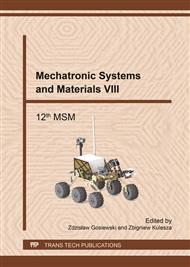p.219
p.227
p.235
p.241
p.249
p.258
p.266
p.278
p.289
Identification of Parametric and Momentary Damages on the Basis of Lindeberg-Levy’s Model
Abstract:
Article presents the innovative method for the assessment of reliability condition of the exploited system, based on the appropriate analysis of changes in the current parameters of technical condition aRb and the regulation condition aRc, determined from the compressed condition equation (1 and 2). While analyzing the course of momentary parameters for technical condition aRb and the regulation condition aRc, it was observed that the parametric and momentary damages can be identified on the basis of quantitative relations between momentary threshold value dpr and corresponding momentary permissible value dpr dop, which are calculated from equation (7, 8, 9) resulting from Lindeberg-Levy’s theorem. It is assumed that the damages are prevailing, when for the moment θi: dpri>dpr dopi. With the number of damages (damage map), reliability parameters for each moment of exploitation of technical object (before the catastrophic damages will occur) can be determined. Parametric damages (expected lifetime E(T) and standard deviation of expected lifetime σE(T) provides the reasonable information for the appropriate planning of the servicing of exploitative objects.
Info:
Periodical:
Pages:
249-257
Citation:
Online since:
July 2017
Authors:
Price:
Сopyright:
© 2017 Trans Tech Publications Ltd. All Rights Reserved
Share:
Citation:


